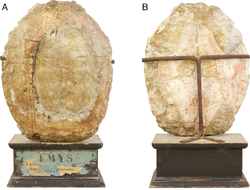| Plesiochelys Temporal range: Jurassic, | |
|---|---|
 | |
| Holotype shell of Plesiochelys. The shell is mounted upside-down | |
| Scientific classification | |
| Kingdom: | Animalia |
| Phylum: | Chordata |
| Class: | Reptilia |
| Clade: | Pantestudines |
| Clade: | Testudinata |
| Clade: | † Thalassochelydia |
| Family: | † Plesiochelyidae |
| Genus: | † Plesiochelys Rütimeyer, 1873 |
| Type species | |
| †Plesiochelys etalloni (Pictet & Humbert, 1857) | |
| Other species | |
| |
| Synonyms [1] | |
Synonyms of P. etalloni:
| |
Plesiochelys ("near turtle") is a genus of late Jurassic European and Asian turtle. The type species is Plesiochelys etalloni. [1]
Contents
Fossil records have discovered Plesiochelys bigleri and Plesiochelys etalloni from the Kimmeridge Clay of England and outside the Swiss and French Jura Mountains. [3]
A recent study [4] placed Plesiochelys as an Angolachelonia and outside Testudines.
